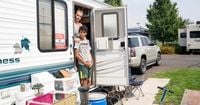On a crisp September morning, as the sun cast long shadows over a patchwork of RVs in a southern Oregon campground, 12-year-old Dante Reynolds zipped past rows of trailers on his kick scooter. He pulled up to the 22-foot travel trailer that, for the past several months, has been home to him, his mother Andrea Stitt, and his younger sister. Inside, space is tight—no tables or chairs, just a makeshift bed covered by a SpongeBob blanket where Dante now helps prepare lunch, chopping fruit while his mom cooks hamburger patties on a small gas range. It’s a far cry from the four-bedroom home they lost earlier this year, but it’s the reality for a growing number of Americans who have turned to RV living as housing costs soar beyond reach.
According to the RV Industry Association, about 486,000 people now live full-time in RVs, more than double the number from just four years ago. A separate Census Bureau survey found that in 2023, 342,000 people were living in an RV, boat, or van—a 41% jump since 2019. These aren’t just retirees fulfilling a lifelong dream of seeing the country or digital nomads chronicling their adventures on social media. About a third of full-time RV dwellers have children, and the vast majority earn less than $75,000 a year, as reported by NBC News.
For families like the Stitts, the move to an RV wasn’t a lifestyle choice but a necessity. After a medical emergency forced Andrea to shutter her daycare business in February, missed rent payments piled up. By late May, the family was evicted. Andrea used her last $3,000 to buy a 28-year-old RV from an elderly woman, and the family downsized drastically, selling or giving away most of their belongings. Now, their home is a Tetris puzzle of bins and sleeping areas, every flat surface stacked with essentials and keepsakes.
When they can’t afford campground fees—typically $25 to $45 a night—they park on remote federal lands, which are free for two weeks but offer no water, electricity, or reliable cell service. “I’ve adapted to this lifestyle because we have to adapt,” Dante told NBC News. “If we don’t adapt, we won’t change, and if we don’t change, we’ll be mad, and if we’re mad, that just sucks. You don’t want to be mad.”
His mother, Andrea, faces daily challenges most homeowners never consider: conserving water, finding places to bathe, and stretching every dollar. She’s now working 25 hours a week as a daycare teacher, but with average rents in her area at $1,650 a month, traditional housing remains out of reach. “I’m either going to have to be a rich person or a poor person because middle class isn’t possible anymore,” she said.
Stories like theirs are becoming more common as America’s housing affordability crisis deepens. Dan Emmanuel, director of federal research for the National Low Income Housing Coalition, explained, “There’s just a huge housing affordability challenge in this country, and that’s part of a larger cost-of-living challenge I think we’re generally having. It’s structural, particularly for the lowest income group. In virtually every housing market, it’s there.”
The numbers back this up. NBC News analyzed housing data and found that the gap between median household income and the income required to afford a median-priced home is at its highest in nearly a decade. In Chattanooga, Tennessee, for example, home prices have soared almost 50% since July 2020, reaching $325,000, while average rents have climbed 40% to $1,534. Debbie Williams, 66, sold her five-bedroom home in Kentucky in 2022, hoping to buy another near her children and grandchildren. But as prices rose, she realized her $100,000 nest egg wouldn’t stretch far enough. Now, she lives in a $29,000 RV, paying $550 a month for a spot in an RV park—her utilities included.
For some, the transition to RV life has brought unexpected benefits. Debbie has created a sense of home outside her trailer, with an outdoor rug, patio furniture, and a fire pit. She’s even adopted the park’s stray cats. “At my age, do I want to do a 30-year loan on a house and then struggle because I would have to pay the mortgage, and then I would have to pay utility bills and insurance and somebody to mow my grass if I can’t do it myself?” she said. “I looked at the future, and I’m thinking, my gosh, could I even enjoy my life? I’d have to work a couple jobs.”
But for many, the hardships of RV living outweigh the perks. RVs aren’t built for full-time habitation, and the wear and tear takes a toll. Repairs are frequent and costly, from broken air conditioners and leaking pipes to engine failures that can cost thousands. Kat Tucker, a 64-year-old disabled veteran, moved into an RV in 2017 to cut housing costs but soon faced a cascade of breakdowns: six new tires, a broken refrigerator and toilet, a dead generator, and finally, an engine repair she couldn’t afford. She had to move out but continued paying a $500 monthly loan for several years. “It can be a great lifestyle, but it can also be yet another trap for poor people who just keep getting poorer,” she said. Last year, she took out another $22,500 loan for a used RV, with seven years of payments ahead and doubts the camper will last that long.
Others, like Gus Francis, 66, have learned to improvise. Living in a small, aging RV near Chattanooga, he can’t use the stove for fear of gas leaks or the shower due to plumbing issues. Instead, he heats water in a bucket and uses a camping shower. “My motto, I think it’s a military term, is improvise, adapt and overcome,” Francis said. “Don’t freak out because you don’t have everything that most people think are necessities. I have them, but they’re a bit more of a problem to utilize than you would in a conventional home or even like Debbie’s size trailer, but I make it work.”
Even retirees who might once have imagined crisscrossing the country in comfort are feeling the pinch. Legendary Detroit news anchor Mort Crim, now 90, spends long stretches in his RV, documenting his travels with his cat Groucho. He finds joy in the unexpected: “Part of the fun in driving across the country in an RV is the serendipitous nature of the journey. You never know what you’ll find that you aren’t expecting,” he wrote on Facebook. But even for those who choose the lifestyle, rising costs for repairs, fuel (sometimes exceeding $100 a day), and campground fees (now $75 or more a night in some places) are squeezing budgets.
Despite the struggles, some RV dwellers find silver linings. Dante, for one, has discovered a love of the outdoors, learning to fish and cook and spending more time with his family. “I think it’s actually better than having a big house because I’ve learned a lot of stuff this summer,” he said. “I’ve learned more in three months than I have in my whole entire 11 years of being alive.”
The road ahead for America’s RV residents remains uncertain. As housing prices continue to climb and the cost of living rises, more families may find themselves trading square footage for wheels, adapting to a life on the move—one challenge, and one small victory, at a time.




